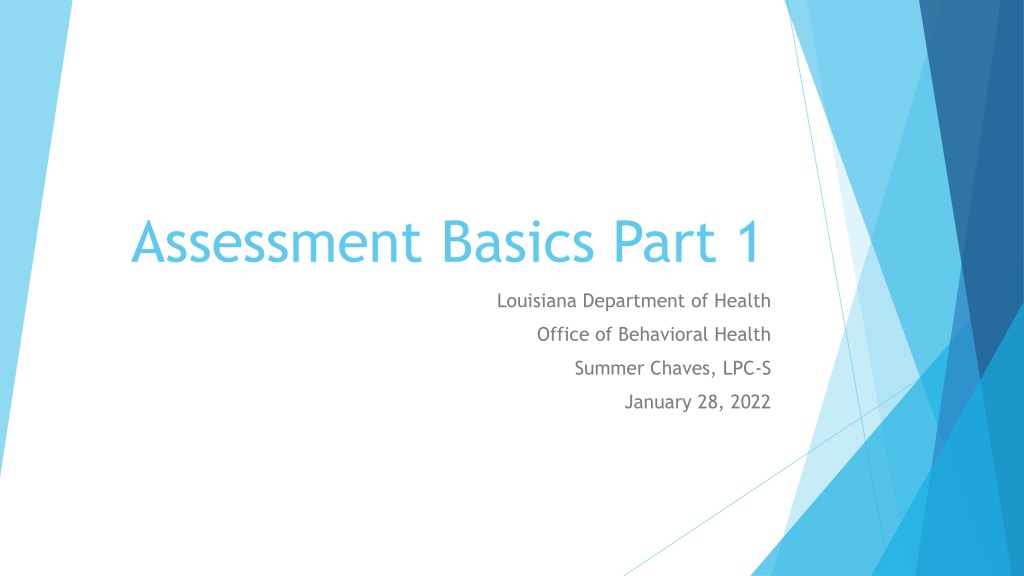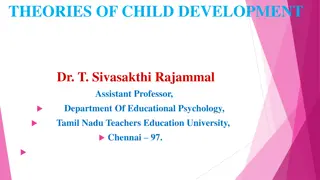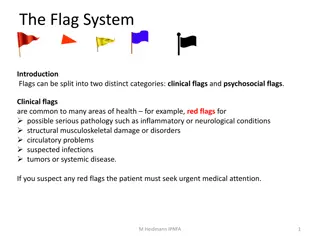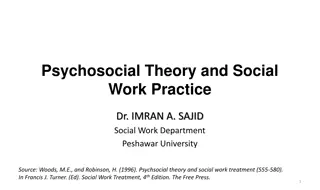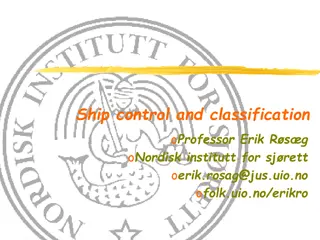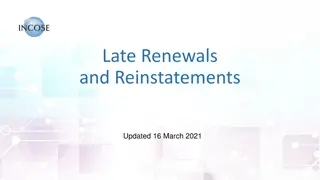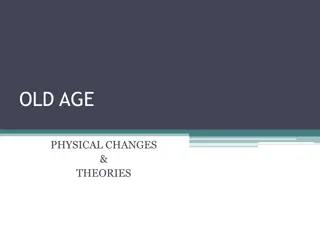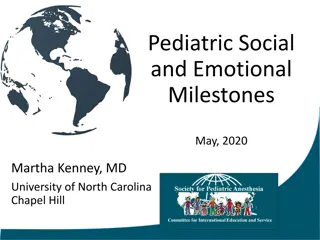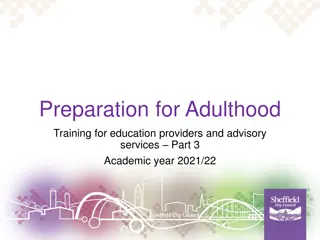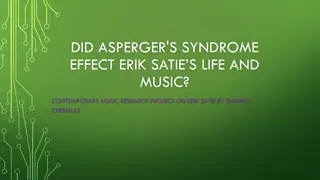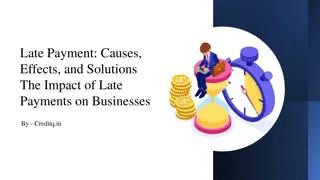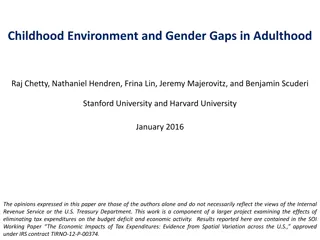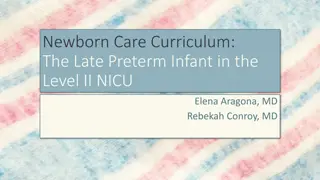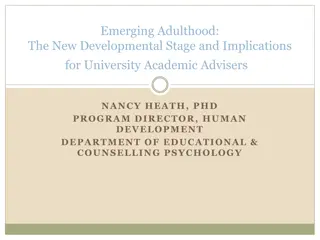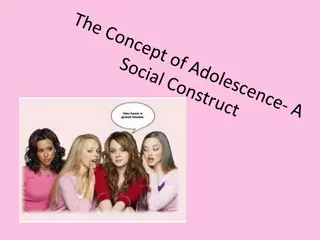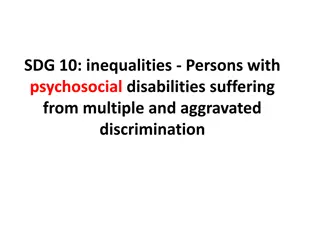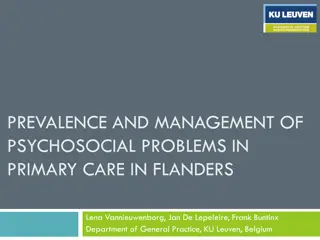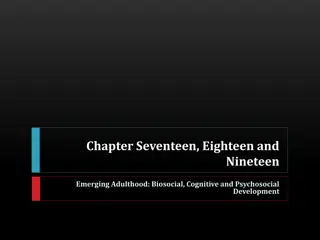Understanding Late Adulthood Psychosocial Development - Erik Erikson's Perspective
Late adulthood brings the stage of Integrity vs. Despair according to Erik Erikson, where reflection on life's achievements leads to either satisfaction or despair. Revisiting earlier life stages in the ninth phase can evoke new conflicts. Successful adjustment may lead to gerotrancendence, a deeper connection to life and the universe.
Download Presentation

Please find below an Image/Link to download the presentation.
The content on the website is provided AS IS for your information and personal use only. It may not be sold, licensed, or shared on other websites without obtaining consent from the author. Download presentation by click this link. If you encounter any issues during the download, it is possible that the publisher has removed the file from their server.
E N D
Presentation Transcript
Assessment Basics Part 1 Louisiana Department of Health Office of Behavioral Health Summer Chaves, LPC-S January 28, 2022
A good assessment is not an end in itself. The assessment process provides the care manager an opportunity to begin to engage on a human level with the client and the family and is a first step in establishing the relationship that will be instrumental in helping the older adult and the family to navigate the aging process. Theme of Person Centered Planning sheds light on the goal of the PASRR Level II Evaluation: Nothing about us without us
Erikson: Integrity vs. Despair As a person grows older and enters into the retirement years, the pace of life and productivity tend to slow down, granting a person time for reflection upon their life. They may ask the existential question, It is okay to have been me? If someone sees themselves as having lived a successful life, they may see it as one filled with productivity, or according to Erik Erikson, integrity. Here integrity is said to consist of the ability to look back on one s life with a feeling of satisfaction, peace and gratitude for all that has been given and received. Sense of meaning (i.e., integrity) through careful review of how their lives have been lived (Krause, 2012). Ideally, however, integrity does not stop here, but rather continues to evolve into the virtue of wisdom. According to Erikson, this is the goal during this stage of life. If a person see s their life as unproductive, or feel that they did not accomplish their life goals, they may become dissatisfied with life and develop what Erikson calls despair, often leading to depression and hopelessness. This stage can occur out of the sequence when an individual feels they are near the end of their life (such as when receiving a terminal disease diagnosis). Lumen, Life Span Development: Module 10: Late Adulthood, Psychosocial Development in Late Adulthood, https://courses.lumenlearning.com/wmopen-lifespandevelopment/chapter/psychosocial-development-in-late-adulthood- 2/
Eriksons Ninth Stage Re-examined the eight stages and created additional thoughts about how development evolves during a person s 80s and 90s. After Erik Erikson passed away in 1994, Joan published a chapter on the ninth stage of development, in which she proposed (from her own experiences and Erik s notes) Older adults revisit the previous eight stages and deal with the previous conflicts in new ways, as they cope with the physical and social changes of growing old. During the ninth stage, Erikson argues that the dystonic, or less desirable outcome, comes to take precedence again. For example, an older adult may become mistrustful (trust vs. mistrust), feel more guilt about not having the abilities to do what they once did (initiative vs. guilt), feel less competent compared with others (industry vs. inferiority) lose a sense of identity as they become dependent on others (identity vs. role confusion), become increasingly isolated (intimacy vs. isolation), feel that they have less to offer society (generativity vs. stagnation), or[2] The Erikson s found that those who successfully come to terms with these changes and adjustments in later life make headway towards gerotrancendence, a term coined by gerontologist Lars Tornstam to represent a greater awareness of one s own life and connection to the universe, increased ties to the past, and a positive, transcendent, perspective about life. Lumen, Life Span Development: Module 10: Late Adulthood, Psychosocial Development in Late Adulthood, https://courses.lumenlearning.com/wmopen-lifespandevelopment/chapter/psychosocial-development-in-late-adulthood- 2/
Challenges and Adjustments Coping with losses and change Establishing meaningful roles Exercising independence and control Finding meaning in life
Cohen's Four Stages of Maturity Cohen's phases (stages) are more fluid than Erikson's; he notes that people may experience them in a different order from the one presented here, or they may overlap. Phase I Midlife Reevaluation (ages mid-30s to mid-60s) Phase I is a period of quest more than crisis. It involves searching for truth and meaning. Where have I been? Where am I now? Where am I going? People in this phase commonly confront their mortality. Although for some this produces anxiety, the Inner Push usually results in an exciting new look at what we want to do with our lives. This may mean doing something differently or something entirely new. Midlife people often become less impulsive, more thoughtful about their work, more open to life's complexities, and more aware of their intuitive feelings. Meanwhile, the brain is aiding the Inner Push by expanding the corpus callosum. This increasing integration of both sides of the brain produces more balance between the analytical and the intuitive, resulting in greater productivity and a stronger sense of self. It's a great time to start a new project or direction. Four phases of aging: Beyond Erikson's integrity versus despair, by Jean Illsley Clarke, M.A., CFLE; https://www.ncfr.org/ncfr-report/focus/family-focus-aging/four-phases-aging-beyond-erikson-s-integrity-versus-despair
Cohen's Four Stages of Maturity Phase II Liberation (ages late 50s into the 70s) Phase II is a time of experimentation and innovation. In the busy brain, new neurons are growing in the hippocampi where dendrites reach their greatest density from the early 50s to late 70s. The Inner Push is toward liberation, not compliance, toward innovation and willingness to take risks. For many, retirement means time to do the things they always wanted to do. The questions are: If not now, when? Why not? What can they do to me? Four phases of aging: Beyond Erikson's integrity versus despair, by Jean Illsley Clarke, M.A., CFLE; https://www.ncfr.org/ncfr-report/focus/family-focus-aging/four-phases-aging-beyond-erikson-s-integrity-versus-despair
Cohen's Four Stages of Maturity Phase III Summing Up (ages late 60s through 80s) Phase III is a time of review and resolution and heralds a desire to give back. The review is of one's life with recognition of its meaning. It is a time of putting photos in albums, of writing memoirs. It may be that the richness of the autobiographical activities is aided by the ability to use the left and the right sides of the brain simultaneously. The left side is mostly used by young adults. Cohen speculates that the brain "relishes" the summing-up activities. Cohen's research indicates that 80% of those in the summing-up phase do some sort of volunteer work. Common questions are: What is the meaning of my life? How do I give back, make the world a better place? Are there unresolved conflicts I can make right? Four phases of aging: Beyond Erikson's integrity versus despair, by Jean Illsley Clarke, M.A., CFLE; https://www.ncfr.org/ncfr-report/focus/family-focus-aging/four-phases-aging-beyond-erikson-s-integrity- versus-despair
Cohen's Four Stages of Maturity Phase IV-Final Phase Encore (ages the late 70s until the end of live) Cohen states, This need to remain vital can lead to new manifestations of creativity and social engagements that make this period full of surprises. Cohen sees the Inner Push fostering reflection and celebration. This phase continues aspects of the three previous phases: reexamination, liberation, and summing up. Hence the name encore is used in the French sense of "continuing." Although some qualities of intellectual functioning decline, new dendrites, synapses, and neurons are continually being created, especially if there is adequate physical and mental stimulation. Not only is learning always possible, but the depth of experience gives an added dimension of wisdom to the quality of one's thinking. Cohen cites research indicating that the oldest-old can cope well and have high levels of satisfaction and psychological resilience. Four phases of aging: Beyond Erikson's integrity versus despair, by Jean Illsley Clarke, M.A., CFLE; https://www.ncfr.org/ncfr-report/focus/family-focus-aging/four-phases-aging-beyond-erikson-s-integrity-versus-despair
Cohen's Four Stages of Maturity Several other studies have confirmed these findings even among unhealthy adults. The bottom line: people become better at adapting to their conditions as they get older. Regardless of their health status, older people typically are better prepared in terms of both satisfaction with life and coping capacities to face the vicissitudes of aging. Four phases of aging: Beyond Erikson's integrity versus despair, by Jean Illsley Clarke, M.A., CFLE; https://www.ncfr.org/ncfr-report/focus/family- focus-aging/four-phases-aging-beyond-erikson-s- integrity-versus-despair
Assessment Basics Person Centered and Collaborative Ensure all fields are fully and thoroughly filled out Centered on the wishes of the individual Partnership and Active Participant Obtain all needed clinical documentation Focus on Strengths Strengths-based approach gives equal attention to an individual s abilities, preferences, and goals. Ensure information is CURRENT By looking first for the person s assets, rather than their liabilities, you will convey hope for recovery and respect for the person served Speak in plain language Ensure there is no contradictory information and if so, obtain clarification Person Centered Language vs Clinical Language Open Ended Questioning followed by structured questions. Always start with the assumption that the individual s needs can be met in the least restrictive setting, THE COMMUNITY. Verify all demographic info Verify all facility info Verify family/caregiver info Presentation: Person Centered Planning: The Four P sU by Virginia Selleck, PhD and Peggy Swarbrick, PhD, FAOTA Make sure you sign with your credentials
Aspects of a Thorough Assessment Preferred Language/name Work History Where they live/living situation/home safety/elder abuse Independence level Mental Health History/suicidal ideations/trauma history Hobbies/interests/social activities/limitations Substance and Alcohol use/abuse Marital Status Insurance/financial situation Children Spiritual/religious preferences Family/friend/community support Advance Directives Other Legal statuses
Goals of Assessment Overall Goal: end up with an INDIVIDUALIZED and COMPREHENSIVE picture of the individual What you need to get: Information as the individual sees it as well as information as how caregivers see it Based on partnership with the individual and caregivers Accurate Presenting Problem Assessment reflects records and documentation Detailed Social History Detail Medical History Can clearly determine individuals abilities, strengths, and liabilities Family/Caregiver Input Can clearly determine if mental illness history is present Cognitive and Behavioral Issues/Decline OVER TIME Can make confident recommendation for least restrictive placement Functional Decline OVER TIME (ADLs) Can make individualized recommendations for supportive services based on well documented needs.
Assessing the Older Adult The following four slides are geared towards issues typically found in assessing older adults. However, this information can still be applied to any individual that is being assessed.
Priorities in Assessing Older Adults Maintain a person-in-environment perspective in understanding human functioning and well-being. Respect and promote older adults rights to dignity and self determination. Attend to maintaining quality of life for older adults and family systems. Promote social justice, including reducing barriers to wellbeing in later life. Promote older adults coping and problem-solving capabilities. Committed to person-centered, team approach in conducting, implementing and evaluating assessments. Advocate for agency practice in person/family centered assessments consistent with social work values. centeronaging.med.edu
Communicating with Individuals During the Assessment Speak to residents the same way you would speak to any adult. Even if a resident s behavior is sometimes childish, they are still a grown-up and will feel insulted if you speak to them as if they were a child. When talking to a resident, be aware of your facial expressions. Even if you re saying something kind, it doesn t make the resident feel good if you re frowning at the same time. Give residents time to respond to questions. Remember that some may get easily confused, and some may take a little longer than others to do things. When possible, sit next to a resident instead of across the table from them. If you sit across from someone, sometimes it can seem threatening or unfriendly. Psychosocial Needs of the Elderly: Learner s Guide (September 2007) Kansas Association of Homes and Services for the Aging Speak loudly and clearly so the resident will understand you but do not yell. https://www.youtube.com/watch?v=- eHPugoC5sE
Hearing Loss and the Assessor Hearing loss is often progressive with aging. High frequency sounds are the first to be lost. Some residents wear hearing aids. Others either cannot or will not wear them. Some are totally deaf. These changes require the caregiver to communicate in different ways. Some examples of changes may be these scenarios: Speak in short, concise sentences. Give only one direction at a time. Don t shift topics. At times, you may need to question the resident to be sure he or she understands you. If a resident has hearing aids, make sure he or she wears them. Also make sure the aids are in good working order. Learn how to turn the volume up and down, and learn how to replace the batteries. Hearing aids are very expensive, so handle them with respect. Be aware of your facial expressions match your facial expressions to your message. If there is background noise, hearing-impaired residents will have even more trouble hearing conversation. Limit background noise by closing the door and turning down the television or radio while you are talking to them. If residents have trouble hearing, look directly at them, lower the pitch of your voice, and speak loudly, clearly, and a bit slower but do not yell. Try not to become frustrated if you have to repeat yourself. Many residents can understand you better if they can look at your face, and especially your mouth, as you speak. Because high pitched sounds are lost first, often it is helpful to lower the pitch of the voice. Psychosocial Needs of the Elderly: Learner s Guide (September 2007) Kansas Association of Homes and Services for the Aging
The process of acquiring a clinical history and interviewing a patient requires effective communication, active listening skills, and tailoring communication to the patient based on the patient's needs, values, and preferences. The National Institute on Aging, in guidance for conducting a clinical history and interview, suggests that clinicians should avoid interrupting, demonstrate empathy, and establish a rapport with patients (NIA, 2008). Clinicians need to know when to ask more detailed questions how to create a safe environment
Sections of PASRR Level II Assessment Living Situation Info (past and current) Chief Complaint Community Services Used (including OCDD involvement) Description of the Problem as seen by family or caretaker Employment History Problem/Illness History Educational History Current Behavioral Health Provider and Services Current Functional Status/Impairment Behavioral Health History Mental Status Exam Decline in Psychiatric Status Mood and Behavior Assessment Substance Use History Risk Assessment Current Medical Conditions Cultural and Language Preferences Medication Compliance and Additional Medical History Diagnosis Info on Additional Therapies Identified Needs Social History Recommendations Family History Assessment Trauma History
PASRR Level II Assessment: A Person Centered Assessment Strength-based Assessment includes, and prioritizes, gathering information on what the person is doing now that contributes positively to their health, wellness, and recovery. In addition, the assessment captures areas where the person has current skills and assets related to their desired goal. What the person does now for wellness and recovery Current skills and assets Function-focused What the person does, has done, and can do Skills, activities, tasks for success in life roles The idea of function reflects how the person performs skills, activities, and tasks that can lead to success and satisfaction in life roles that are meaningful to them. Adapted from AOTA. (1995). Position paper: Occupational therapy s definition of function. American Journal of Occupational Therapy, 49, 1019-1020; and Anthony, W. A., Cohen, M., Farkas, M., & Gagne, C. (2002). Psychiatric rehabilitation (2nd ed.). Boston: Boston University Center for Psychiatric Rehabilitation.
PASRR Level II Assessment: A Person Centered Assessment The assessment process is collaborative and relevant to the person s life vision and goals. Understand the person s vision for achievement or improvement in one or more settings, environments, or life domains, and wellness. Focus on function within the person s desired setting, environment, or life domain. Assess strengths and assets in relation to success in relevant settings, environments, or life domains. Assess challenges, barriers, needs in relation to success and satisfaction in relevant settings, environments, or life domains. Identify priority needs through collaborative dialogue Presentation: Person Centered Planning: The Four P sU by Virginia Selleck, PhD and Peggy Swarbrick, PhD, FAOTA
Psychosocial Interview: Mental Health vs Mental Illness Mental health is a state of well-being where there is the ability to deal with the typical stresses of life, works productively, and contribute to their community. Mental illness is a pattern of behaviors that is troubling to the person or the community where the individual lives. Mental illness may modify reality, influence daily living, or harm judgment Mentally ill individuals often have a reduced ability to cope with society, maladaptive behaviors, and a reduced ability to function. CEU on Psychosocial Assessment: A Nursing Perspective by Raymond Lengel, Julia Tortorice
Psychosocial Interview The major components of a psychosocial interview include: Identifying the patient Violence risk assessment Chief complaint Family or social history History of presenting illness Occupational history Psychiatric history Educational history Medical or surgical history Legal history Medication list Developmental history Alcohol and drug use Spiritual assessment Cultural assessment Interests Financial assessment Abilities Coping skills Mental status examination CEU on Psychosocial Assessment: A Nursing Perspective by Raymond Lengel, Julia Tortorice
Identifying the Patient A patient's identity includes patient's name, gender, birth date or age, marital status, race, ethnicity, and languages spoken This information is usually captured in the Identifying Information section of the PASRR Level II Evaluation. Other items to consider are grooming, gestures, mannerisms, psycho-motor movements, communication, intellectual functioning, and affect. These may be recorded in the comprehensive narrative. All of this info gives us a visual picture of the individual. Think of what we would need to know to identify this individual in a group of other individuals.
Chief Complaint and Presenting Problem Chief Complaint is the person s understanding of the problem. In their own words What caused them to seek services What caused them to need NF level of care Who referred them for NF level of care Presenting Problem provides information regarding a client s most immediate needs while exploring the problematic areas within a person s life. Info from the individual AND others What has led up to the event that caused them to seek services. Looking for a precipitating event. What happened that caused the referral for NF placement? What are the troublesome symptoms, behaviors, and problems that are affecting their Day-to day functioning, Relationships, Work
History of Present Illness and Functioning Interview Family/Caregivers as well as the individual. Be watchful for discrepancies between the two. Getting reliable and adequate information about the past history may be a challenge due to poor memory of the patient and inadequate information from the accompanying family members. Onset, Duration, Severity and Fluctuation Precipitating Factors/Life Events Previous Treatment Attempts How did you try to address these concerns before? How helpful was it? Who were the providers? Functioning History What could you do before that you cannot do now due to these issues? See attachment for additional questions to consider
Behavioral Health History History of past diagnosis, hospitalizations, treatments, medications, response to treatments and noted side effects. Put together a timeline if able. Need a complete picture of the illness history. May go back more than 2 years. Look for trends Previous interventions are any previous mental health treatment/services that the member has received. Types of interventions that have been provided to the individual The date of the mental health interventions The name of the mental health provider The outcome of the treatment Did their symptoms improve Reason for discharge What goals was the member working on in the past
Questions to Better Assess Behavioral Health (BH) History How long has individual had BH diagnosis? What occurred that brought on this diagnosis? What types of treatment has individual had? Hospital stays related to individual s BH? Any legal involvement related to individual s BH? Is individual at risk of harm to self or others? Has individual been at risk of harm to self or others? Describe the progression of the individual s BH. What was it like early on when individual was diagnosed What is it like now How has it impacted individual s functioning over time-social, mood, hobbies, etc
Psychiatric Decline in Status Timeframe is defined (3 6 months) Capture a clear picture of what these behaviors and the decline in status looks like (one word responses are not telling) What could they do before the decline that they cannot do now? What where they doing/saying that indicated a decline in status? When did this occur? What were the precipitating events? What was the intervention to reduce the behaviors? How was it successful or unsuccessful? What was the result of these behaviors?
Additional Questions to Consider in Assessing a Decline in Psychiatric Status Describe functioning prior to the decline in mental status and functioning. Always ask for examples Ask for time frames Ask for clarification, do not assume you understand what is meant if it is not specific What could individual do then that they cannot do now? What behaviors were not present then that are present now? What behaviors were present then that are not present now? What other changes do you notice now that were not present in the past when the individual was doing better but are present now and are a concern? social, mood, hobbies, ability to manage emotions
History Taking in Reverse: Beginning With the Social History BARRY J. WU, MD, FACP Yale University Physician-Centered Person-Centered Let me start at the beginning. Tell me . . . Where were you born? Do you smoke? What level of schooling have you completed? Do you drink? What is a typical day like for you what time do you wake up, what do you have for breakfast, then what do you do, what do you have for lunch, then what do you do, what you have for dinner, then what do you do, when do you go to bed? Do you use illicit drugs? How much do you smoke? How much do you drink? What recreational drugs have you tried before?
History Taking in Reverse: Beginning With the Social History BARRY J. WU, MD, FACP Yale University Physician-Centered Person-Centered Do you have any family history of heart attack, stroke, cancer, diabetes, hypertension, or hyperlipidemia? Tell me about your mother. How old is she? What medical problems does she have?
Assessing Family History What is their relationship like with their family? What kind of family support do they have? Where do the family members live? What are the strengths and challenges of their support system? What types of contact do they have (regular visits )? Are they married/widowed? If they re married what is their spouses health like/limitations? How many children, if any, do they have? Where do they live? What is their relationship like? Do they have grandchildren or great children? What is their relationship like? Who is their primary Caregiver? Does their primary Caregiver have any health related issues? What are the strengths and challenges of their support system?
Assessing for Trauma History When broaching the subject of trauma, ask the client if he/she has ever experienced any traumatic events such as witnessing or experiencing: car accidents or other types of accidents, natural disasters, war, adult/ childhood physical or sexual assault, having been threatened Reliable reporting of events is best obtained by asking about specific event types. Under-reporting of exposure tends to occur when people are asked only broad questions such as Have you ever experienced a traumatic event? [287].
Questions End of Part 1
